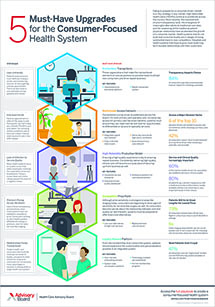Auto logout in seconds.
Continue LogoutIn 2017, Medtronic hired Yoko Sen, an ambient electronic musician, and gave her an unusual task: to create about 10 tones for the company's remote heart monitor, STAT News' Eric Boodman reports.
Innovation 101: Cheat sheets for today's digital world
The problem with today's medical beeps
The alerts and beeps that fill hospitals and patients' homes today are defined by the International Electrotechnical Commission (IEC) Standard 60601-1-8.
The tones were first set by the International Organization for Standardization in 2003. IOS settled on two main alert patterns: "three beats for semi-urgent alarms, and five beats for dire ones," Boodman writes. IOS tasked Frank Block Jr., a musician-turned-clinician who is now a professor of anesthesiology at the Augusta University/University of Georgia Medical Partnership, and other members of the working group to compose tunes that fit the alert pattern.
Medical device companies were able to choose whether to use those works or "write their own within haiku-like constraints," Boodman writes.
"Quite honestly, most of the companies went with a fixed pitch," Block said, adding, "They said, 'We don't like your tunes, we're not musicians, we don't have composers on staff, we're just going to use a fixed pitch.' So that's what's happening today.'"
But those widely used tones have created a problem. As Joseph Schlesinger, assistant professor of anesthesiology and critical care medicine at Vanderbilt, said, "Now, we have alarms that are easily confused and difficult to learn and don't really tell us what's wrong."
Block said, "I literally have had in the OR a cardiac monitor and an anesthesia machine and an infusion pump, and they were all going bahm bahm bahm, they were all making identical sounds, and they were all compliant with the current edition of the 60601-1-8."
Why Medtronic hired its own music consultant
So as Medtronic looked at updating alert tones for the heart monitor that accompanies its implantable cardiac defibrillators, it decided to try a new approach.
The monitor, Boodman explains, serves "as a kind of cardiac satellite, taking in data on how well a person's blood is being pumped and then beaming the information out to a webpage for their physician to check."
Jenny Ramseth, a director of customer experience at Medtronic, said the company decided to hire Sen in part out of concerns about their heart monitors' omitting sounds that "might be too alarming."
Jasmine Wylie, an administrator of a 7,000-person Facebook support page for patients with implantable cardiac defibrillators, said patients often leave the hospital with little education on their new device, and the sounds it emits—say, a beeping warning the device needs a new battery—can be frightening.
Medtronic asked Sen, in essence, "to compose a Suite for Bedside Monitor, in which each movement had only half a second to tell patients about the transmission of their cardiac data," Boodman writes. He explains, "One jauntier piece might have been titled 'Properly Sent to Physician Portal.' Another, on the more serious side, might be 'Wi-Fi Trouble.'"
How Sen approached her compositions
Sen, along with Medtronic scientist Stephen Nelson, spent months exploring different sounds for the bedside monitor.
She and Nelson first experimented with changing the timbre of the three current heart monitor sounds—including one that Boodman describes as "a buzzy, two-toned bleep"; "a long note, followed by two lower chirps; and "a series of static beeps." But they realized changing the timbre would require Medtronic to completely redesign the device's buzzer.
So instead, they shifted their focus to melody. They devised a list of frequencies that would be audible to elderly patients, and Sen took that list to a friend and saxophonist, who helped her program "a keyboard so that it could play only the permitted tones."
Using the keyboard, Sen composed, tested, and adjusted new variations. Sen landed on tones that "lowered the frequency of the [device's] tones and simplified the patterns—more ornament than melody, more 'oops' than 'red alert,'" Boodman writes.
The tones, Boodman writes, were "attention-getting but comfortable" and "less grating than the original sounds, but retaining a bit of bite."
When will the sounds be available?
Patients won't be able to hear the final sounds for quite some time. Boodman reported that as of September the new heart monitor device was still under development and would need to receive regulatory approval before hitting the market (Boodman, STAT News, 9/10).
Innovation 101: Cheat sheets for today's digital world
Download our cheat sheets so you can keep track of the fast-changing technologies and capitalize on opportunities for IT-powered innovation. Check out our guides for these topics and more:
Don't miss out on the latest Advisory Board insights
Create your free account to access 1 resource, including the latest research and webinars.
Want access without creating an account?
You have 1 free members-only resource remaining this month.
1 free members-only resources remaining
1 free members-only resources remaining
You've reached your limit of free insights
Become a member to access all of Advisory Board's resources, events, and experts
Never miss out on the latest innovative health care content tailored to you.
Benefits include:
You've reached your limit of free insights
Become a member to access all of Advisory Board's resources, events, and experts
Never miss out on the latest innovative health care content tailored to you.
Benefits include:
This content is available through your Curated Research partnership with Advisory Board. Click on ‘view this resource’ to read the full piece
Email ask@advisory.com to learn more
Click on ‘Become a Member’ to learn about the benefits of a Full-Access partnership with Advisory Board
Never miss out on the latest innovative health care content tailored to you.
Benefits Include:
This is for members only. Learn more.
Click on ‘Become a Member’ to learn about the benefits of a Full-Access partnership with Advisory Board
Never miss out on the latest innovative health care content tailored to you.

